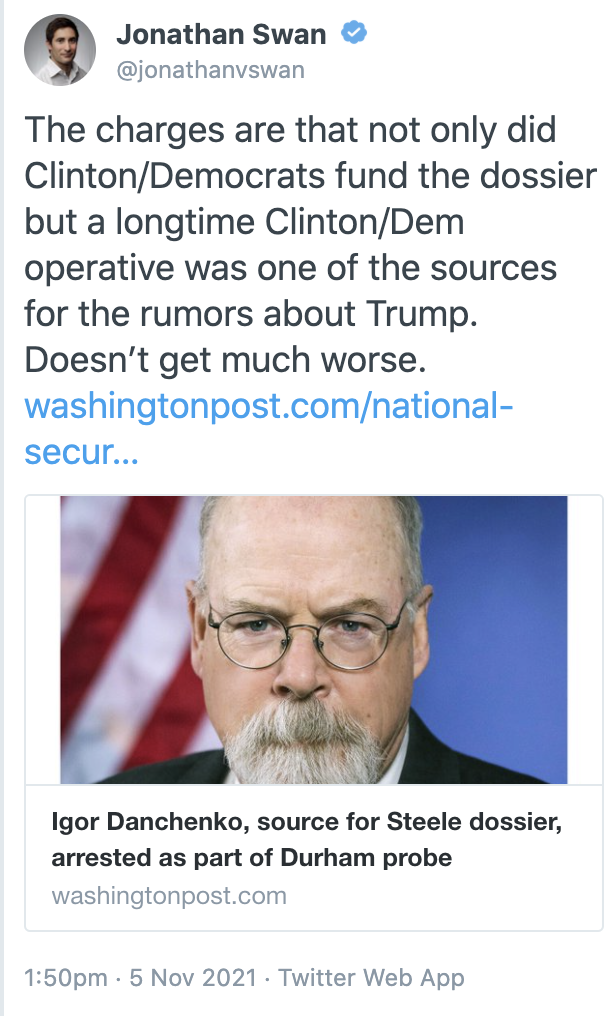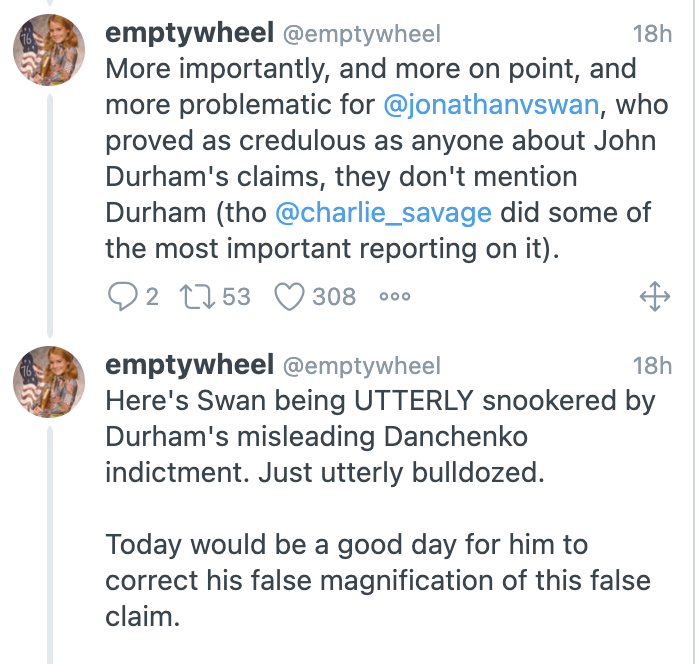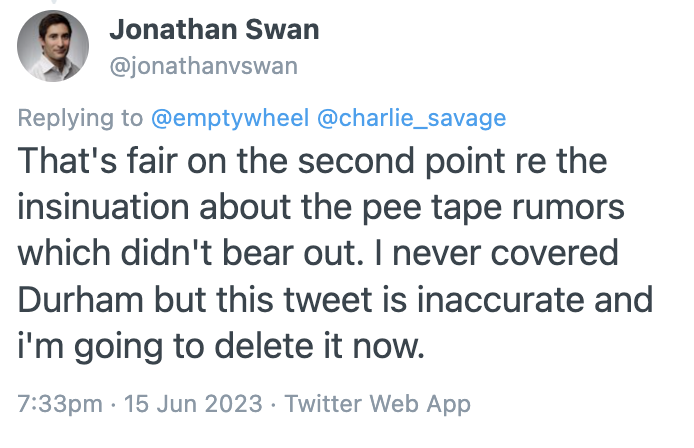How Jonathan Swan Covered [Up] John Durham’s Corruption
Something funny happened yesterday.
Full-time Trump-whisperer Maggie Haberman, Trump-whisperer Jonathan Swan, and DOJ reporter Charlie Savage wrote a story responding to Trump’s promise to appoint prosecutors to investigate Joe Biden and his family just like Biden’s own DOJ has done (which they note). They described that if Trump won a second term, he would “appoint an ally who would bring charges against his political enemies regardless of the facts,” then described how Jeffrey Clark and Russell Vought were already working on the plan.
Mr. Trump appeared to be promising his supporters that he would appoint an ally who would bring charges against his political enemies regardless of the facts.
[snip]
Mr. Clark and Mr. Vought are promoting a legal rationale that would fundamentally change the way presidents interact with the Justice Department. They argue that U.S. presidents should not keep federal law enforcement at arm’s length but instead should treat the Justice Department no differently than any other cabinet agency. They are condemning Mr. Biden and Democrats for what they claim is the politicization of the justice system, but at the same time pushing an intellectual framework that a future Republican president might use to justify directing individual law enforcement investigations.
They make no mention of the cases on which Bill Barr attempted to do just that — bring charges against Trump’s political enemies regardless of the facts: Greg Craig, Jim Comey, Andrew McCabe, John Kerry, among others (though Savage has covered them).
The only mention of Barr’s unprecedented past success at politicizing DOJ includes an important error.
Under Mr. Barr, the Justice Department overruled career prosecutors’ recommendations on the length of a sentence for Mr. Trump’s longest-serving political adviser, Roger J. Stone Jr., and shut down a case against Mr. Trump’s first national security adviser, Michael Flynn, who had already pleaded guilty. Both cases stemmed from the Russia investigation.
Barr’s DOJ did not succeed at shutting down Mike Flynn’s prosecution, in which a sentencing memo, approved by Barr’s DOJ, had already been submitted by the time Barr commenced his efforts. Emmet Sullivan was still deciding whether to grant DOJ’s request to throw out Flynn’s guilty plea when Trump pardoned Flynn; and when Sullivan finally did dismiss the case, he reaffirmed Flynn’s guilty verdict.
NYT’s silence about how Trump really overturned Flynn’s conviction, a pardon, carries over generally. These journalists join Kaitlin Collins in warning of future Trump corruption without bothering to catalog or hold Trump accountable for his past unprecedented corruption, the pardons he used to reward those who lied about what really happened with Russia in 2016. That’s the opposite of accountability journalism, warning of future corruption while remaining silent about the similar corruption that already happened.
But the weirdest thing, coming as it does from a team including both Swan and Savage, is that NYT made no mention of the Durham investigation, in which a Special Counsel appointed under Trump literally did, “bring charges against [Trump’s] political enemies regardless of the facts.”
The silence from Savage is unfortunate given that he has done such important work laying out how that’s what Durham did.
Swan’s silence is more inexcusable.
That’s because — as I documented in real time — Swan was absolutely central in disseminating Durham’s unsubstantiated insinuation that a “Clinton/Dem operative” (Durham’s claim itself relied on exaggeration) was behind the pee tape.
Swan’s judgement, a neutral journalist not just magnifying and repeating Devlin Barrett’s shitty reporting on the Igor Danchenko indictment (Barrett said charges, plural, were tied to Charles Dolan and falsely claimed that Durham had alleged Dolan was the source for the dossier, “rather than well-connected Russians”), but adding his judgment that it “doesn’t get much worse,” went viral, accepted as fact.
I pointed that out, with a hot link to his earlier Tweet.
Swan responded. He ignored the clear factual error about Flynn and the point about pardons, but he conceded that his Tweet “is inaccurate.”
So he deleted it, with only this Tweet recording that he did so and no apology to the two innocent men, Charles Dolan and Igor Danchenko, he falsely accused and — with his viral tweet and his considerable credibility as a journalist — led others to falsely accuse, having done so because of the deliberately misleading way Durham had presented his charges against Danchenko.
Most curiously, Swan explained that he, “never covered Durham.”
It’s absolutely true that he never laid out how Durham, a Special Counsel Trump demanded and got, brought “charges against his political enemies regardless of the facts,” as Savage has. Swan never even, as Barrett did, reported on an indictment and misleadingly claimed uncharged allegations in it were charged conduct. Swan wasn’t the experienced DOJ reporter who first fell for Durham’s affirmatively misleading charging document, Barrett was.
But as a journalist, Swan disseminated Durham’s unsubstantiated, uncharged claims, exacerbated by Barrett’s shitty reporting, and people took his report as true. Swan played a key role in leading the public to believe that a prosecutor who charged Danchenko for making a literally true statement to the FBI about his contact with Dolan had instead found something so bad that, “it doesn’t get much worse.”
Perhaps his role was unwitting. But Swan played a key role in helping Durham to make and lead the public to believe in false claims, “regardless of the facts,” precisely the topic that Swan and his colleagues suggest is just a prospective threat from Trump.
And much of the public still believes Durham’s false claims, in (small) part because of Swan’s own actions.
John Durham is going to go before Congress next week and be asked to explain and repeat demonstrably false claims — outright fabrications, in some cases — that he made in his report. Durham will likely renew his claims, made in his report, that Michael Sussmann and Igor Danchenko lied, even though two juries told him that he made those accusations, “regardless of the facts.”
And Swan, who generously describes that, “the pee tape rumors didn’t bear out,” rather than that a prosecutor made the claim “regardless of the facts,” Swan, who believes the topic of prosecutors who make false claims “regardless of the facts” is a topic worth reporting, thinks that deleting evidence of his own role in disseminating such false claims is sufficient, even as Durham continues to do Trump’s bidding of making false claims in real time.
John Durham is precisely the threat that Haberman and Swan and Savage warned about prospectively, but Swan, having played a role in leading the public to believe Durham’s false claims “regardless of the facts,” thinks that merely deleting the evidence that that’s what Durham has done is sufficient.
If the threat of prosecutors charging Trump’s enemies “regardless of the facts” is worth reporting, than Durham’s ongoing corruption must be covered, not covered up.


